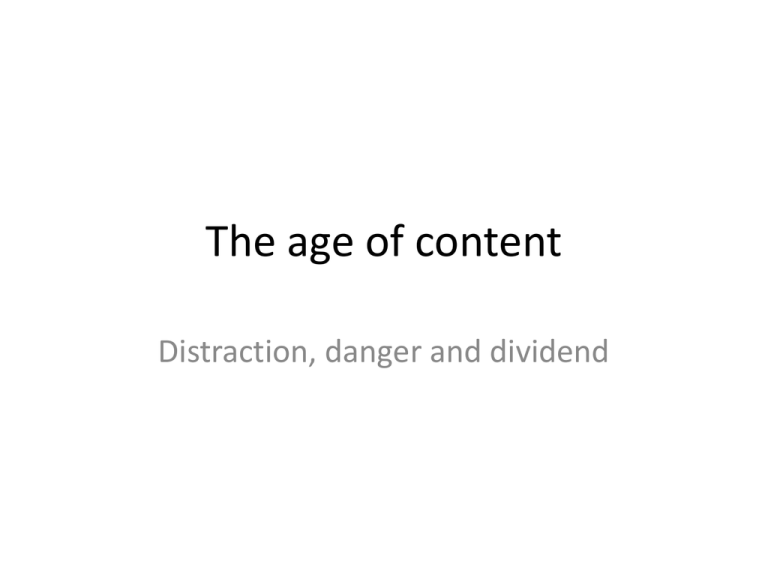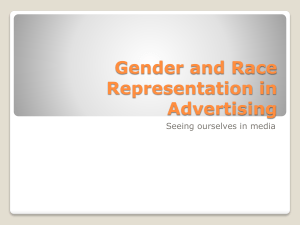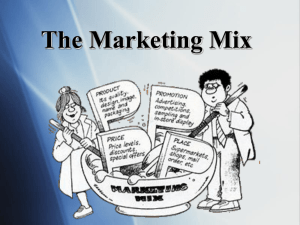The age of content
advertisement

The age of content Distraction, danger and dividend Me: • • • • Name: Bruno Jakić MSc A.I. (Online+Gaming) Entrepreneur Founder of Ai Applied: automatic text analysis and understanding • Author: history of technology lovers, check out the book “Hacking Europe” • If someone from the 1950s suddenly appeared today, what would be the most difficult thing to explain to them about life today? • I possess a device, in my pocket, that is capable of accessing the entirety of information known to man. • I use it to look at pictures of cats and get in arguments with strangers. A brief history of “content” • 1950’s: Newspapers, LP’s, 3 TV channels… – Not called “content”, instead “news”, or “music”… – Produced by rare, skilled professionals after years of training (limited access) – Produced using analog tools – Disseminated through tightly controlled channels – Generally local audiences, consuming at leasure – Paid for by the audiences – Genuinely limited supply: scarcity A brief history of “content” • 1950’s: – Music studio cost: ~ US$ 500.000,- (in current money) [1] – 1 minute of real-time international communication (telephone equipment could only be LEASED): ~ US$ 50,- per minute ( in current money) [2] – Sending delayed information to another continent (mailing a letter): ~ US$ 1,- [2] (1) (2) The audio recording handbook, By Alan P. Kefauver, A-R Editions (April 2001) Trends in Globalization, by World Trade Organization (2013) A brief history of “content” • 1959: Jack Kilby invents the Integrated Circuit A brief history of “content” • 1964 onwards: Mass production of IC • Moore’s Law (3) Wgsimon, Wikipedia: A brief history of “content” • 1990’s: digital production, 10s-100s of TV channels, early Internet – Produced by (abundant) professionals – Produced using digital tools (by professionals, wide access) – Mostly disseminated through controlled channels – (Sometimes artificially) limited supply – Increasingly globalized audiences, consuming at leasure – Paid for, or “pirated” by the audiences, or through large-scale advertising A brief history of “content” • 1990’s: – Music studio cost: ~ US$ 50.000,- (in current money) [4] – 1 minute of real-time international communication (telephone): ~ US$ 5,- per minute (in current money) [2] – Sending delayed information to another continent (e-mail): ~ US$ 0,- [2] (4) 25 Products That Changed Recording, Sound on Sound magazine (November 2010) A brief history of “content” • ~ 2004: “Web 2.0”, “Social Media”, participatory content creation A brief history of “content” • 2004-Now: The Internet, digital, personalized TV – Seen and called “content” by channel owners: associations with bulk goods – Produced by (part-timing and abundant) professionals, mostly by audiences / amateurs (universal access) – Mostly disseminated online – Almost unlimited supply: abundance – Globalized, massive audience, consuming in real-time – Paid for by advertising – Audiences are not the customers A brief history of “content” • 2004-Now: – Music studio cost: ~ US$ 5.000,- [5] – 1 minute of real-time international communication (Skype): ~ US$ 0,- per minute [2] – Sending delayed information to another continent (email): ~ US$ 0,- [2] – Contributions by the audience: ~US$ 0,- (+ tech costs) (5) Warbeats.com (November 2013) The age of content: paradigm shift • Paradigm-shift in economic value of content • 90% of the world’s data in 2013 (about 4,5 zetaBytes) – created since early human civilization - was created in the two years prior [6] • Significant amount of this data consists of customer-generated content [6] • A lot of content, on its own = ~low value (6) Big Data, for better or worse: 90% of world's data generated over last two years, Science Daily (22nd of May, 2013) The age of content: paradigm shift • In case of content supply scarcity, value is in content: consumer = paying customer • In case of content supply abundance, content is a means to an end: consumer ≠ paying customer • Paying customers: millions of companies represented by advertising networks The age of content: consumer as a commodity Consumer is the product! The age of content: dividend • Consumer value: – – – – – – Facebook: US$ 128,- [7] @ 1230 mil. users Twitter: US$ 118,- [7] @ 255 mil. users LinkedIn: US$ 84,- [7] @ 277 mil. users Angry Birds: US$ 11,51 [8] @ 260 mil. users Whatsapp: US$ 35,- [9] @ 450 mil. Users Nu.nl (news): US$ 145,- [10] @ 1 mil. users (7) You're Worth $128 On Facebook; Sorry About That LinkedIn Drop, Forbes (2014) (8) ThinkGaming (2014), MerchandiseReport (2014) (9) Acquisition by Facebook (2014) (10) Sanoma net sales 2014 (2014) The age of content: dividend • Global online advertising yearly revenue (2013): ~US$ 117.000.000.000,- [11] The age of content: dividend • Consumer value: – Direct spending – Advertising: • • • • • Specific branding (US$1000+) eCPM (US$ 0,01 to US$ 30,-) CPC (US$ 0,01 to US$ 10,-) Revenue-sharing (up to 30% of the purchase price) Price based on specific user targeting • Online advertising value depends on volume, time The age of content: dividend • Increasing consumer value: – Get more consumers to view your content more often for more time • Vested interest of and proactive effort from content channels to attract and keep customers The age of content: distraction • Behavioral marketing (e.g. @ Stanford Business School since 2004) studies scientifically: – – – – – – – – – Decision making Attitudes and persuasion Social influence Motivation Cognition Culture Nonconscious behavior influences Consumer neuroscience Emotions The age of content: distraction • Content marketing strategy: – Goals: • • • • Boost rankings for search-keywords Establish domain authority Establish brand authority on subject Provide useful content for consumers – Methods: • Link/click-baiting • Optimizing lay-out and colors of presentation • Adaptive writing style: articles not too long and not too short • When people are in, keep them in with “filler” and a few good articles The age of content: distraction • Link baiting: – Use infographics – Niche resource guides – Hyperbole/provocative imagery in titles – Question-answer statements in titles – Ego driven content – Negative content – Incentives The age of content: distraction ’I actually got pointed to a video that was on YouTube via Upworthy, that was originally just called "Zach Wahls Talks About His Family." Zach Wahls is a bloke from the states raised by two gay moms. And the video, which was quite a passionate testimony from him, got a million views. It was rebranded to be called "Two Lesbians Raised A Baby, And This Is What They Got." And with that headline, it got 17 million views.’ – Steve Hind, Link-baiter The age of content: distraction The age of content: distraction The age of content: danger • Domain authority ≠ domain knowledge – Consumers might be vastly under informed whilst thinking they have gained full insights into a domain • Popularity , agreeability≠ truthfulness or correctness – Consumers might be vastly misinformed leading to serious consequences • Deemed useful by consumers ≠ desired – Consumers do not a-priori INTEND to engage with the content out of their own volition – Consumers might spend inordinate amounts of time learning about something they deem pleasant or useful, but which it practically is not The age of content: danger • • • • • Massive waste of time Psychological distress and addiction Catering to the lowest common denominator Promoting lack of proper education Knowledge becomes indeterminate, indeterminable and ultimately, superfluous • Menace to society The age of content: danger • Time spent on content: The age of content: danger • Content marketing is also employed by “reputable” media sources as well, such as newspaper channels which already have longestablished authority • Crackpot theories presented as “scientific” are difficult to recognize. • Every preconceived notion is supported somewhere, locking customers into their own bubble and out of the accepted reality The age of content: danger • Viral hypes with severe consequences: “vaccines cause autism” • Recent outbreaks of meazles, polio whooping cough… The age of content: danger • Alternative medicine communities provide anectdotal reciprocal support despite unproven efficacy (with deadly consequences). The age of content: danger • News outlets: less and less journalism, more and more articles • Nu.nl: 1.2 1 0.8 Articles/Journalist (indexed to 1402) 0.6 Parrot-index 0.4 0.2 0 2007 2008 2009 2010 2011 2012 2013 2014 (12) Ai Applied/ Jelle Boumans Phd dissertation (2014) The age of content: solutions • Age of contènt → Age of contént? The age of content: solutions • Currently, content channel owners have a vested interest to PUSH content onto everyone, all the time, for as long as possible. Quantities matter. • Profitable because advertisers can reach a large ROI; small advertising budgets work miracles if they reach the RIGHT people. • Only profitable because of precise targeting of advertisements. The age of content: solutions • The solution: deny advertising networks your personal information • Without precise targeting, ROI declines. Advertising as it is happens is no longer feasible. • Content channel owners will have vested interest in cultivating a community, rather than wasting your time (as with TV in the 90s). The age of content: solutions - now • Think about what you’ve heard today • Use false data on social networks (for now) • Browsing privacy protection tools: – Disconnect – Privacy Badger – NoScript • Private operating systems: – Tails Linux (formerly Amnesia) • Anonymous/dark net: – TOR – Anomos The age of content: solutions - future • “Pay me, Facebook” • Freedom box • Networks of trust • To succeed widely, must have a business model • Community-operated ad networks? A brief future of “content”? • 2024: – Music studio cost: ~ US$ -1000,– 1 minute of real-time international communication (QuantumMessenger): ~ US$ -1,- per minute – Sending delayed information to another continent (ContentNet): ~ US$ -1,- [2] (5) Warbeats.com (November 2013) The age of content: solutions paramount EDUCATION


